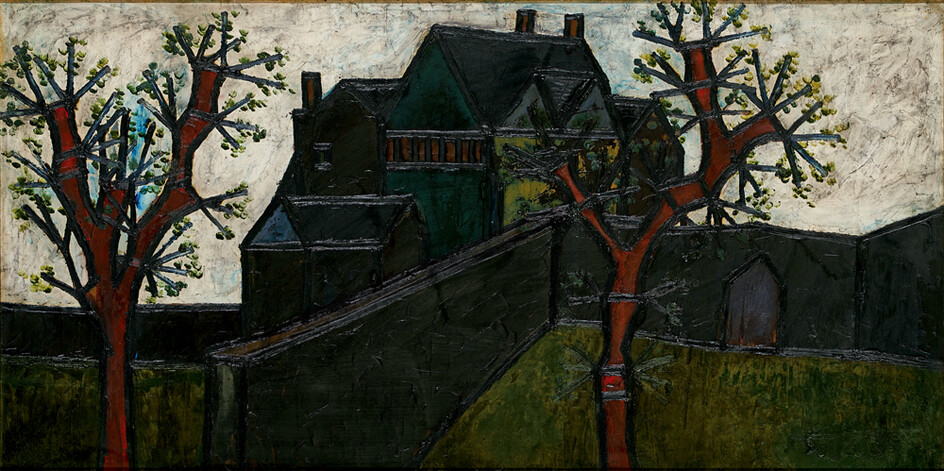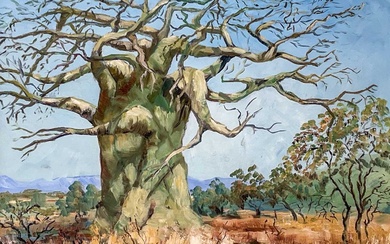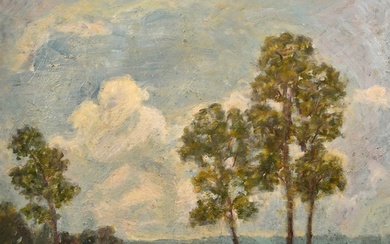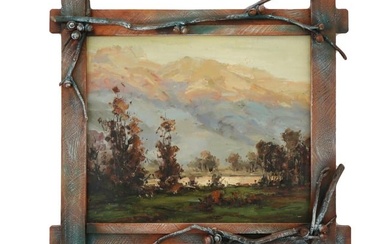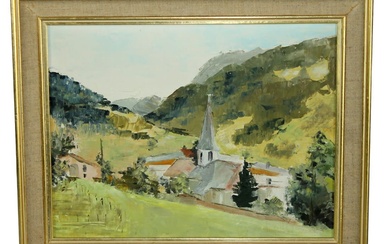Landscape with Two Trees
PROPERTY OF A GOAN COLLECTOR
Oil on board
1955
24 x 48 in. (61 x 122 cm.)
Signed and dated ‘Souza 55’ lower right and further signed, dated and inscribed ‘F. N. SOUZA / LANDSCAPE / WITH TWO TREES / 1955 / OIL ON BOARD / 48" X 24" ’ on reverse
PROVENANCE:
Purchased by the current owner from F.N. Souza’s first wife, Maria, in 1990.
‘A new chapter in contemporary Indian art began on Monday evening, when Souza’s exhibition was opened. For the first time we were enabled to come face to face with the work of a genius... Indian painting will never be the same again.’ (The Times of India, 26th March 1963)
Souza’s journey from the backwaters of Goa to international critical acclaim was not an easy one. Three months after the artist was born, his father died, and so as a young child, Souza moved with his mother from Goa to Mumbai, where he attended St Xavier’s High School, which was run by Jesuit priests. He was expelled from the school at fifteen, for allegedly drawing pornographic images on the walls of the school bathrooms. A charge he flatly denied, he later claimed that if he had drawn the offensive material, the drawings would have been better! Aged sixteen, Souza enrolled at the Sir J.J. School of Art in Mumbai, from which, five years later, he was suspended for joining Gandhi’s Quit India Movement. His rebellious nature was a defining feature of his personality, which proved to be both a hindrance and a driving force in his career.
Souza states, ‘on the day I was expelled from the J.J. School of Art in 1945, I marched home indignantly, told my astonished mother what had happened – I was 21 years old then, had grown an Errol Flynn moustache and I smoked cigarettes from a holder like Robert Donat – and started furiously painting in oils with a palette knife on a large piece of plywood my mother had bought to use as a cutting table top for dressmaking. I painted an azure nude with a still-life and landscape in the background. I finished the painting in an hour of white heat. I titled it The Blue Lady and exhibited it in my first one man show in December 1945. Fifty selected paintings and drawings from a total of a couple of hundred works, all done within six months from the date of my expulsion.’ (F.N. Souza, ‘The Progressive Artists’ Group’, The Patriot Magazine, 8 February 1976, p. 4)
This intense period of creative expression, marks for many, the start of Souza’s career as an artist. Edwin Mullins, in his monograph on the artist, explains, that The Blue Lady was utterly different from anything he had ever done before. ‘It was an angry impulsive picture, and in painting it he discovered the way he wanted to paint.’ Souza never returned to art school, and instead, returned for a period of time to Goa, where he painted local scenes and the local people. ‘In those days I was painting peasants and rural landscapes. I painted the earth and its tillers with broad strokes, heavily outlining masses of brilliant colours. Peasants in different moods, eating and drinking and toiling in the fields, bathing in a river or a lagoon, climbing palm trees, distilling liquor, assembling in a church, praying or in procession with priests and acolytes carrying the monstrance, relics and images; ailing and dying, mourning or merrymaking in market places and feasting at weddings.’ (F. N. Souza, ‘Nirvana of a Maggot’, republished, Words and Lines, London, 1959, p. 13)
The landscapes that Souza mentions, created towards the end of the 1940s, are for the most part, medium-format works on paper in bright colour tones, painted in a range of styles, from Impressionistic to abstract. Like his colourful paintings, there is a sense of joyful nostalgia in his written reminiscences of Goa, recounted in his autobiographical essay ‘Nirvana of a Maggot’, which was first published in London by Stephen Spender in Encounter magazine in 1955; the same year that the current lot was created. The sense of nostalgia is telling, for his initial experiences of living in post-War London could not have been more different from his Goan sojourn. The London that confronted Souza when he arrived was war-torn and dirty, with food rationing still in place. Souza was, for the most part, penniless, and his lifestyle in London was far from glamourous. He probably would not have been able to survive in London without the support of his first wife, Maria.
In 1945, a young lady called Maria Figueiredo, met Souza at his first solo exhibition held at the Bombay Arts Salon, and purchased a work on paper titled Ave Maria for forty-eight rupees, equivalent to half her weekly wage. The meeting was to prove important, for two years later, Souza and Maria were married. According to Maria’s daughter, Shelley Souza, Ave Maria hung in their various homes throughout her mother’s life, and despite Souza divorcing her mother, Maria remained one of Souza’s most steadfast supporters. Importantly, in these early years in London, Maria’s work as a couturier helped to provide financial support to Souza, before he independently found fame and financial success. The current landscape was purchased directly by the present owner from Maria Figueiredo’s personal collection in London.
Surprisingly, little is mentioned of the support that Maria provided Souza in these early years. However, in a letter written to Maria in 1984, Souza states, ‘I have always appreciated the way you have rooted for my art, you were involved in it almost from the time I was out of Art School and had started out on my own; you were there when the Progressive Artists’ Group happened, and later when I and you moved to London, Husain and the other Indian artists, some of them living in Europe, like Raza and Padamsee, would drop in, and you would go to Paris to visit them... So you see, you have been connected with Indian Contemporary Art, and I am sure history will write it...’ (published in an online article about Souza’s painting, The Red Road, written by Maria Aurora Couto for Sotheby’s)
Despite his recent marriage, Souza left for London by himself. He recalls his arrival in England, ‘I disembarked at Tillbury on a hot August day in 1949 with £15 in the pocket of my only suit. In London, I took up lodgings on my own. I bought paint and brushes with £10 and spent the rest on food and a week’s rent. I worked hard on my painting and hoped for the best. I felt awfully alone in the largest populated city in the world. I walked aimlessly and bewildered through the bewildering traffic.’ (F.N. Souza, The Patriot Magazine, op.cit., p. 4)
The landscapes that Souza began to create once he arrived in London tend to reflect his sombre mood, and are more formal compositions than his Goan period landscapes. Dark buildings are strung out along a low horizon, which are defined in thick, black outlines, enclosing small windows of deep colour. Unlike the bright Goan scenes, full of sunshine and communal activities, these London landscapes are devoid of humanity and can appear cold and brutal. Despite a pervading sense of gloom, the paint is applied boldly in confident thick strokes, giving a glossy richness to the composition, which heralds a new style of painting. In the current example, Souza has offset the formal structure of a single large building with two striking trees, divided by a tall wall. The trees appear to be lime trees that have been heavily pruned, a common sight on the streets of Notting Hill, Hampstead and Belsize Park, where he lived at various moments during his London career. The unusual sculptural forms, created by these trees, clearly appealed to Souza, as this type of tree appears frequently in his paintings and drawings from the mid-1950s.
Like many other artists before him, Souza was drawn to forms of empirical geometry as symbols of God’s creative energy. He explains his theory in some personal notes on artistic technique. ‘The analysis of these forms is that they are geometric compounds of the square and the circle. And the one is really inseparable from the other. 2 such squares dissected by the circle produces the ellipse. Parts and combinations of both can produce an unending pattern in all directions. The two forms together symbolise the linga (lingant) yoni capable of endless reproduction and multiplication.’ (F.N. Souza, transcribed from personal notes and published in Francis Newton Souza, exhibition catalogue, Saffronart and Grosvenor Gallery, Mumbai, 2005, p. 48)
These landscapes, therefore, are in essence, a play of geometric forms that evolve from these basic elements of the line, square, circle and ellipse. Souza never allows this formula to break down into pure abstraction, but at this period, he is surprisingly strict in restricting himself to these basic elements, which are especially prominent in his landscape paintings. The resulting compositions, are sometimes compared to those that Akbar Padamsee created in the early 1950s, or the Parisian rooftops painted by S.H. Raza in the mid-1950s. Although it is clear, that at this stage of their careers, all three artists were inspired by each other’s work, Souza’s approach to his compositions remains more rigid. His line is unwavering, and never dissolves into gestural fluidity, which was to only appear later, in his crumbling ‘apocalyptic’ cityscapes of the early 1960s. In terms of structure, they are closer to the cityscapes of Bernard Buffet.
In 1955, Souza held his first solo exhibition at Victor Musgrave’s Gallery One in London. The sell-out show was an immediate springboard to critical acclaim. He was suddenly considered one of London’s most exciting new artists, being compared to Graham Sutherland and Francis Bacon, which allowed him greater freedom. A year later, Souza met Harold Kovner in Paris, who became an important patron to the artist, providing him with a monthly stipend and some much needed financial stability. Between 1955 and 1963, Souza held five one-man exhibitions with Victor Musgrave at Gallery One, where he...
View it on
Sale price
Estimate
Reserve
Time, Location
Auction House
PROPERTY OF A GOAN COLLECTOR
Oil on board
1955
24 x 48 in. (61 x 122 cm.)
Signed and dated ‘Souza 55’ lower right and further signed, dated and inscribed ‘F. N. SOUZA / LANDSCAPE / WITH TWO TREES / 1955 / OIL ON BOARD / 48" X 24" ’ on reverse
PROVENANCE:
Purchased by the current owner from F.N. Souza’s first wife, Maria, in 1990.
‘A new chapter in contemporary Indian art began on Monday evening, when Souza’s exhibition was opened. For the first time we were enabled to come face to face with the work of a genius... Indian painting will never be the same again.’ (The Times of India, 26th March 1963)
Souza’s journey from the backwaters of Goa to international critical acclaim was not an easy one. Three months after the artist was born, his father died, and so as a young child, Souza moved with his mother from Goa to Mumbai, where he attended St Xavier’s High School, which was run by Jesuit priests. He was expelled from the school at fifteen, for allegedly drawing pornographic images on the walls of the school bathrooms. A charge he flatly denied, he later claimed that if he had drawn the offensive material, the drawings would have been better! Aged sixteen, Souza enrolled at the Sir J.J. School of Art in Mumbai, from which, five years later, he was suspended for joining Gandhi’s Quit India Movement. His rebellious nature was a defining feature of his personality, which proved to be both a hindrance and a driving force in his career.
Souza states, ‘on the day I was expelled from the J.J. School of Art in 1945, I marched home indignantly, told my astonished mother what had happened – I was 21 years old then, had grown an Errol Flynn moustache and I smoked cigarettes from a holder like Robert Donat – and started furiously painting in oils with a palette knife on a large piece of plywood my mother had bought to use as a cutting table top for dressmaking. I painted an azure nude with a still-life and landscape in the background. I finished the painting in an hour of white heat. I titled it The Blue Lady and exhibited it in my first one man show in December 1945. Fifty selected paintings and drawings from a total of a couple of hundred works, all done within six months from the date of my expulsion.’ (F.N. Souza, ‘The Progressive Artists’ Group’, The Patriot Magazine, 8 February 1976, p. 4)
This intense period of creative expression, marks for many, the start of Souza’s career as an artist. Edwin Mullins, in his monograph on the artist, explains, that The Blue Lady was utterly different from anything he had ever done before. ‘It was an angry impulsive picture, and in painting it he discovered the way he wanted to paint.’ Souza never returned to art school, and instead, returned for a period of time to Goa, where he painted local scenes and the local people. ‘In those days I was painting peasants and rural landscapes. I painted the earth and its tillers with broad strokes, heavily outlining masses of brilliant colours. Peasants in different moods, eating and drinking and toiling in the fields, bathing in a river or a lagoon, climbing palm trees, distilling liquor, assembling in a church, praying or in procession with priests and acolytes carrying the monstrance, relics and images; ailing and dying, mourning or merrymaking in market places and feasting at weddings.’ (F. N. Souza, ‘Nirvana of a Maggot’, republished, Words and Lines, London, 1959, p. 13)
The landscapes that Souza mentions, created towards the end of the 1940s, are for the most part, medium-format works on paper in bright colour tones, painted in a range of styles, from Impressionistic to abstract. Like his colourful paintings, there is a sense of joyful nostalgia in his written reminiscences of Goa, recounted in his autobiographical essay ‘Nirvana of a Maggot’, which was first published in London by Stephen Spender in Encounter magazine in 1955; the same year that the current lot was created. The sense of nostalgia is telling, for his initial experiences of living in post-War London could not have been more different from his Goan sojourn. The London that confronted Souza when he arrived was war-torn and dirty, with food rationing still in place. Souza was, for the most part, penniless, and his lifestyle in London was far from glamourous. He probably would not have been able to survive in London without the support of his first wife, Maria.
In 1945, a young lady called Maria Figueiredo, met Souza at his first solo exhibition held at the Bombay Arts Salon, and purchased a work on paper titled Ave Maria for forty-eight rupees, equivalent to half her weekly wage. The meeting was to prove important, for two years later, Souza and Maria were married. According to Maria’s daughter, Shelley Souza, Ave Maria hung in their various homes throughout her mother’s life, and despite Souza divorcing her mother, Maria remained one of Souza’s most steadfast supporters. Importantly, in these early years in London, Maria’s work as a couturier helped to provide financial support to Souza, before he independently found fame and financial success. The current landscape was purchased directly by the present owner from Maria Figueiredo’s personal collection in London.
Surprisingly, little is mentioned of the support that Maria provided Souza in these early years. However, in a letter written to Maria in 1984, Souza states, ‘I have always appreciated the way you have rooted for my art, you were involved in it almost from the time I was out of Art School and had started out on my own; you were there when the Progressive Artists’ Group happened, and later when I and you moved to London, Husain and the other Indian artists, some of them living in Europe, like Raza and Padamsee, would drop in, and you would go to Paris to visit them... So you see, you have been connected with Indian Contemporary Art, and I am sure history will write it...’ (published in an online article about Souza’s painting, The Red Road, written by Maria Aurora Couto for Sotheby’s)
Despite his recent marriage, Souza left for London by himself. He recalls his arrival in England, ‘I disembarked at Tillbury on a hot August day in 1949 with £15 in the pocket of my only suit. In London, I took up lodgings on my own. I bought paint and brushes with £10 and spent the rest on food and a week’s rent. I worked hard on my painting and hoped for the best. I felt awfully alone in the largest populated city in the world. I walked aimlessly and bewildered through the bewildering traffic.’ (F.N. Souza, The Patriot Magazine, op.cit., p. 4)
The landscapes that Souza began to create once he arrived in London tend to reflect his sombre mood, and are more formal compositions than his Goan period landscapes. Dark buildings are strung out along a low horizon, which are defined in thick, black outlines, enclosing small windows of deep colour. Unlike the bright Goan scenes, full of sunshine and communal activities, these London landscapes are devoid of humanity and can appear cold and brutal. Despite a pervading sense of gloom, the paint is applied boldly in confident thick strokes, giving a glossy richness to the composition, which heralds a new style of painting. In the current example, Souza has offset the formal structure of a single large building with two striking trees, divided by a tall wall. The trees appear to be lime trees that have been heavily pruned, a common sight on the streets of Notting Hill, Hampstead and Belsize Park, where he lived at various moments during his London career. The unusual sculptural forms, created by these trees, clearly appealed to Souza, as this type of tree appears frequently in his paintings and drawings from the mid-1950s.
Like many other artists before him, Souza was drawn to forms of empirical geometry as symbols of God’s creative energy. He explains his theory in some personal notes on artistic technique. ‘The analysis of these forms is that they are geometric compounds of the square and the circle. And the one is really inseparable from the other. 2 such squares dissected by the circle produces the ellipse. Parts and combinations of both can produce an unending pattern in all directions. The two forms together symbolise the linga (lingant) yoni capable of endless reproduction and multiplication.’ (F.N. Souza, transcribed from personal notes and published in Francis Newton Souza, exhibition catalogue, Saffronart and Grosvenor Gallery, Mumbai, 2005, p. 48)
These landscapes, therefore, are in essence, a play of geometric forms that evolve from these basic elements of the line, square, circle and ellipse. Souza never allows this formula to break down into pure abstraction, but at this period, he is surprisingly strict in restricting himself to these basic elements, which are especially prominent in his landscape paintings. The resulting compositions, are sometimes compared to those that Akbar Padamsee created in the early 1950s, or the Parisian rooftops painted by S.H. Raza in the mid-1950s. Although it is clear, that at this stage of their careers, all three artists were inspired by each other’s work, Souza’s approach to his compositions remains more rigid. His line is unwavering, and never dissolves into gestural fluidity, which was to only appear later, in his crumbling ‘apocalyptic’ cityscapes of the early 1960s. In terms of structure, they are closer to the cityscapes of Bernard Buffet.
In 1955, Souza held his first solo exhibition at Victor Musgrave’s Gallery One in London. The sell-out show was an immediate springboard to critical acclaim. He was suddenly considered one of London’s most exciting new artists, being compared to Graham Sutherland and Francis Bacon, which allowed him greater freedom. A year later, Souza met Harold Kovner in Paris, who became an important patron to the artist, providing him with a monthly stipend and some much needed financial stability. Between 1955 and 1963, Souza held five one-man exhibitions with Victor Musgrave at Gallery One, where he...
